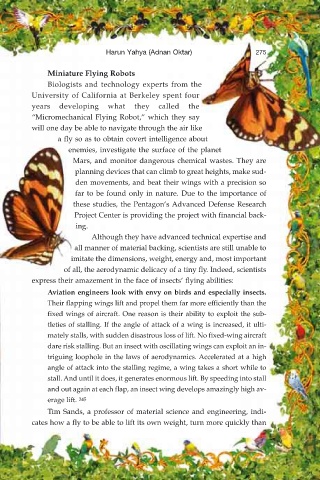Page 277 - The Origin of Birds and Flight
P. 277
Harun Yahya (Adnan Oktar) 275
Miniature Flying Robots
Biologists and technology experts from the
University of California at Berkeley spent four
years developing what they called the
“Micromechanical Flying Robot,” which they say
will one day be able to navigate through the air like
a fly so as to obtain covert intelligence about
enemies, investigate the surface of the planet
Mars, and monitor dangerous chemical wastes. They are
planning devices that can climb to great heights, make sud-
den movements, and beat their wings with a precision so
far to be found only in nature. Due to the importance of
these studies, the Pentagon’s Advanced Defense Research
Project Center is providing the project with financial back-
ing.
Although they have advanced technical expertise and
all manner of material backing, scientists are still unable to
imitate the dimensions, weight, energy and, most important
of all, the aerodynamic delicacy of a tiny fly. Indeed, scientists
express their amazement in the face of insects’ flying abilities:
Aviation engineers look with envy on birds and especially insects.
Their flapping wings lift and propel them far more efficiently than the
fixed wings of aircraft. One reason is their ability to exploit the sub-
tleties of stalling. If the angle of attack of a wing is increased, it ulti-
mately stalls, with sudden disastrous loss of lift. No fixed-wing aircraft
dare risk stalling. But an insect with oscillating wings can exploit an in-
triguing loophole in the laws of aerodynamics. Accelerated at a high
angle of attack into the stalling regime, a wing takes a short while to
stall. And until it does, it generates enormous lift. By speeding into stall
and out again at each flap, an insect wing develops amazingly high av-
erage lift. 245
Tim Sands, a professor of material science and engineering, indi-
cates how a fly to be able to lift its own weight, turn more quickly than

